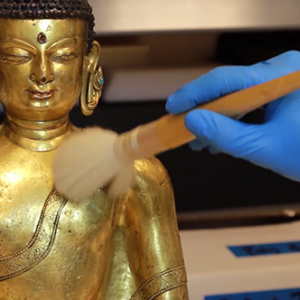
In early May, the museum opened the exhibition Nepalese Seasons: Rain and Ritual. Associate Registrar, Lauren Thompson, gives an exclusive behind-the-scenes account of the exhibition installation process below:
After years of planning, dozens of meetings, checking lists—more than twice—and logistics galore, the time finally comes when we are ready to install the exhibition we have been tirelessly preparing for! The art is finally being brought into the gallery and in just a few weeks’ time, the gallery space will transform from bare walls and carts full of installation equipment to sculptures displayed seamlessly in cases and paintings hung with care.
Getting Ready to Install
The majority of the objects in Nepalese Seasons comes from the Rubin Museum’s own collection. For greater ease, we decided to install the framed paintings first. The first step is to organize the paintings according to their place on the floor plan. The curator and designers decide exactly where they should hang—here is a lot of “move the painting three inches to the left, now up a bit on the right side, go a half an inch back to the right… perfect!”




On to the Sculptures
Once the paintings are hung, the team switches their focus to installing sculptures, which can be much more challenging and time-consuming compared to framed paintings. We have to take into account the preparation of display cases, mounts for display, and any special requirements the piece has for display. The wall and floor cases need to be precisely placed; there is no moving a case once a sculpture is installed inside of it. If a mount does not already exist and the sculpture needs one for display, the mounts are custom-made many weeks (sometimes even months) in advance of an exhibition. The Collections Management department and the exhibition designers work closely with the mount maker to fabricate a safe and seamless mount.
Along with mounts, many bronze sculptures in this exhibition require silica gel as a part of their display requirements.Introducing silica gel into the display case, which serves as a buffering agent, helps to reduce the rate of change in moisture in the environment. This is a type of preventative preservation that helps reduce relative humidity induced damage. We want our objects to shine and last for as long as possible so that our visitors have a chance to enjoy their splendor, both today and for many years to come.






Never Before Seen: Temple Banner Installation
The last objects to be installed are the temple banners. These two pieces have never been on display before, so their appearance is exciting for everyone involved! There were many meetings and consultations to determine the best way to display the banners. The exhibition curator decided sections of the scrolls should be displayed, and the cases were built following those specifications. The Collections Preparator, Registrar, and Conservator all worked months in advance to physically prepare the scrolls for display. You can see from the pictures below that even installing the pieces took a lot of coordination and supervision. But after all the planning, preparation, and precise installation, the work paid off and the display is spectacular.




See the installation as it looks now when you visit Nepalese Seasons: Rain and Ritual, on view through March 2017.
Add Your Thoughts
Comments are moderated, and will not appear on this site until the Rubin has approved them.



